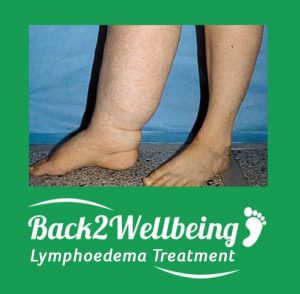Lymphoedema is a long-term (chronic) condition that causes progressive swelling in the body’s tissues. It can occur in any part of the body, but it most commonly affects the limbs. Lymphoedema occurs when your lymphatic system does not work properly. As a network of channels and glands throughout the body, the lymphatic system exists to fight infections and remove excess fluid. If this system isn’t operating as it should, it can cause reduced drainage of fluid from your tissues back into your circulation.
Lymphoedema’s main effect is reduced drainage, which leads to a large build-up of fluid. This can cause severe swelling in all or part of a limb. This can be uncomfortable for an individual and make it difficult to fit into certain clothes or wear jewellery such as rings or watches. Lymphoedema must be identified and treated as soon as possible to prevent it from worsening.

Fluid build-up in the body can happen as a result of the lymphatic system not filtering fluid properly. This can occur if the lymphatic system is not properly formed, is damaged, or if we’re not moving around enough. Severe infections such as cellulitis can trigger Lymphoedema, as can inflammation due to conditions such as rheumatoid arthritis. Any lymph trauma caused by injuries or excess weight can also place pressure on the lymphatic system, which causes lymph fluid to build up. Certain cancer treatments to remove lymph nodes can also disrupt the lymphatic system’s ability to drain fluid adequately.
Lipoedema is a chronic condition causing abnormal and disproportionate fat accumulation in the lower body and sometimes arms. It is a genetic condition that almost exclusively affects women. It typically begins around puberty, and it affects up to 10% of the adult female population.
The Lipoedema symptoms usually begin at times of hormonal change, such as around puberty, and the main noticeable symptom is the development of excess fat in the legs, buttocks, and arms. The visible difference in the size and shape of the parts of the body that are affected can be distressing, and it can even make it difficult to work, which has a huge effect on a person’s mobility. This can lead to feelings of embarrassment, anxiety, and in some cases, depression. Due to its nature of being linked to hormonal changes, Lipoedema fat unfortunately does not reduce by undertaking a low-calorie diet or regular high-intensity exercise, unlike normal excess weight.

Fluid build-up in the body can happen as a result of the lymphatic system not filtering fluid properly. This can occur if the lymphatic system is not properly formed, is damaged, or if we’re not moving around enough. Severe infections such as cellulitis can trigger Lymphoedema, as can inflammation due to conditions such as rheumatoid arthritis. Any lymph trauma caused by injuries or excess weight can also place pressure on the lymphatic system, which causes lymph fluid to build up. Certain cancer treatments to remove lymph nodes can also disrupt the lymphatic system’s ability to drain fluid adequately.
Oedema is water retention in the body, which causes affected tissues to become swollen. The swelling can occur in certain parts of the body, or it can be more widespread. Oedema can be caused by heart, liver, or kidney disease, some side effects of medication or simply from prolonged sitting or standing. High-salt intake, certain injuries and pregnancy can also cause Oedema.
Oedema symptoms include swelling or puffiness, particularly in the ankles, feet or hands, and it can lead to stretched or shiny skin. Other symptoms include stiffness and a feeling of heaviness. While some swelling is temporary, some can be more serious, requiring medical attention to determine the underlying cause.

Oedema is caused by one or more of a combination of being overweight, taking certain medications, sitting in the same position for too long, standing for excessively long periods of time, and eating too much salty food. It can also be caused by certain allergic reactions, heart failure, kidney failure, and liver problems.
The lymphatic system is a circulatory network of organs, vessels, and tissues that protects us from infection. Within the lymphatic system are lymph vessels, which are similar to blood vessels. Their purpose is to drain extra fluid (called lymph) that has passed out of the blood and into tissues, returning it to the bloodstream. If operating correctly, the lymphatic system helps keep a healthy balance of fluids throughout our bodies.
We are proud to be associated with MLD UK, an association made up of practitioners from different professional backgrounds who aim to raise public awareness of Manual Lymphatic Drainage (MLD) and its therapeutic applications. For more information, visit www.mlduk.org.uk today.
We are also proud that our MLD practitioners have qualified in Lymphoedema Specialist Skills via the Casley-Smith MLD course, and our medical-grade treatments follow the British Lymphoedema Society guidelines, known as the ‘Four Cornerstones’. These are: